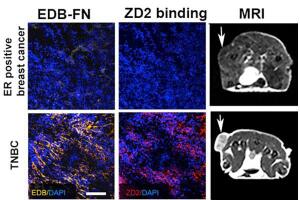by
John R. Fischer, Senior Reporter | September 26, 2017

A new contrast agent can differentiate
between aggressive and slow-growing,
low-risk types of breast cancer at
early stages
Researchers at Case Western Reserve University in Cleveland have created a new MR contrast agent that can locate and differentiate between aggressive and slow-growing, low-risk types of breast cancer at early stages.
The gadolinium-based agent lights up cancer biomarkers during scans, overcoming the low sensitivity of MR for imaging markers, and produces signals with different shades of brightness that contrast aggressive from slow-growing, low-risk types of cancer. The findings were published in the journal,
Nature Communications.
“Current contrast agents do not have the ability to differentiate aggressive breast cancers from low-risk ones,” Dr. Zheng-Rong Lu, the M. Frank Rudy and Margaret Domiter Rudy professor of biomedical engineering at Case Western Reserve and leader of the research, told HCB News. “Current clinical imaging technology doesn't have this ability either.



Ad Statistics
Times Displayed: 45747
Times Visited: 1371 MIT labs, experts in Multi-Vendor component level repair of: MRI Coils, RF amplifiers, Gradient Amplifiers Contrast Media Injectors. System repairs, sub-assembly repairs, component level repairs, refurbish/calibrate. info@mitlabsusa.com/+1 (305) 470-8013
ZD2 peptide-targeted gadofullerene, the chemical name for the agent, is derived from tri-gadolinium nitride metallofullerene (Gd3N@C80) and ZD2, a peptide developed in Lu’s lab.
Unlike gadolinium in traditional agents, ZD2 peptide-targeted gadofullerene consists of gadolinium ions encased in a hollow molecule of fullerene that takes on the shape of a soccer ball and prevents the ions from interacting with human tissue. ZD2 is applied to the surface of the molecule and specifically targets the cancer protein, extradomain-B fibronectin (EDB-FN).
An MR test conducted on six mouse models found that the accumulation of contrast molecules on three aggressive triple-negative breast cancers (MDA-MB-231, Hs578T and BT549) produced a brighter signal compared to slow-moving, estrogen receptor-positive (ER-positive) breast cancers (MCF-7, ZR-75-1 and T47D), the signal of which was muted due to a lesser accumulation of molecules.
In addition to breast cancer, ZD2 peptide-targeted gadofullerene can also be used to differentiate between aggressive and benign forms of prostate cancer, according to preliminary tests, and possibly other types of cancer, based on the biology of the biomarker. It is currently being tested for the same effect in pancreatic cancer.
The agent is also safer and more effective than traditional agents, requiring a gadolinium dose 20-times smaller, and can easily be flushed from the body without accruing in tissues, as found by the researchers during testing.
Lu says that the ZD2 peptide-targeted gadofullerene could possibly become a standard tool among physicians.
”It has the potential to address the drawbacks and limitations of the existing agents,” he said.
Lu and his colleagues are currently working to determine ways to reduce costs for producing the agent, to make it more attractive for clinical use.
ZD2 peptide-targeted gadofullerene does not yet have a commercial name and has not been submitted for FDA approval. However, a similar agent with the same effect is in clinical development for FDA approval.

